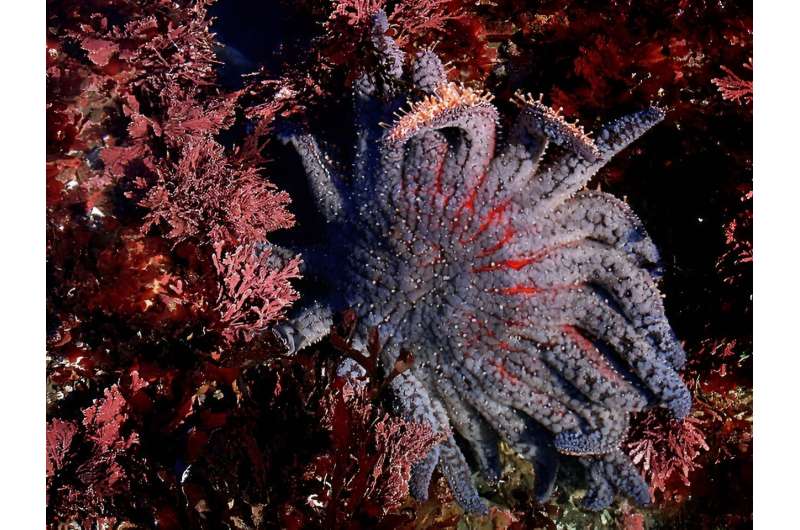This article has been reviewed according to Science X's editorial process and policies. Editors have highlighted the following attributes while ensuring the content's credibility:
fact-checked
reputable news agency
proofread
Sunflower sea stars are critically endangered, but can humans help the species rebound?

There are so few sunflower sea stars remaining, researchers don't think there are enough for them to find each other on their own to reproduce—so the species is getting a helping hand from humans.
The Aquarium of the Pacific in Long Beach and the Birch Aquarium at Scripps Institution of Oceanography in San Diego teamed up with several other labs and scientists to successfully spawn several sunflower sea stars recently, giving hope for the critically endangered species that was nearly wiped out when a sea star wasting syndrome swept the West Coast about a decade ago, killing billions.
"It has been an amazing few years of collaborating and learning that led to this spawning. We have a huge team behind us, both national and international, working toward the conservation of the sunflower sea star," said Jenifer Burney, Aquarium of the Pacific senior aquarist and co-chair of the Association of Zoos and Aquariums SAFE—Saving Animals from Extinction—Sunflower Sea Star Program.
"The future of the sunflower sea star," she said, "just got a little brighter."
The disease that decimated the population to near extinction from 2013 to 2015 is still a mystery, baffling marine scientists from Baja to British Columbia, but especially off the southern and central California regions. Billions of sea stars turned to globs of goo, melting and dying in the largest known die-off of the species.
A range of starfish species, including ochre, mottled, leather, rainbows, six-armed stars and sunflowers, were impacted. Some species are starting to rebound, with occasional sightings off the coast—but one in particular, the sunflower, has not been showing hope.
"We call them 'functionally extinct,'" said Burney. "We don't think there's enough of them here to find each other to reproduce and rebound. We haven't seen them in Southern California for years. For whatever reason, it really hit the sunflower stars the hardest."
The sunflower sea star looks a lot different from the typical five-arm species, she said. They can have two dozen arms and grow so large that their middle part, the disk, can span several feet.
"I think when people see them, they are blown away and don't realize what they are looking at because they don't realize they are sea stars," Burney said.
Their absence is impacting the ocean ecosystem. They diet on sea urchins, but with their populations depleted, the urchins have boomed. That surge in urchins is impacting kelp, which is already experiencing stress from warmer-than-normal waters.
In 2019, the University of Washington Friday Harbor Laboratories had the first successful spawning of the sunflower sea star, fertilizing and growing it in a laboratory.
To expand on that success, SAFE was created, a collaboration that not only including the Aquarium of the Pacific and Birch Aquarium, but also the California Academy of Sciences, San Diego Zoo Wildlife Alliance and Sunflower Star Laboratory.
The group does everything from studying the disease to now spawning the species in an aquaculture setting, early steps to try and help the sunflower sea star rebound one day.
The Aquarium of the Pacific has four female sunflower sea stars at its facility that aquarists tried to fertilize in November, but the effort didn't work.
So the team traveled down to Birch Aquarium, which has a handful of males and one female, to try again.
The sea stars were injected with hormones, releasing eggs and sperm that were combined in a five-gallon bucket. Within 10 minutes, they had several successful fertilized samples.
"It's a really cool process," Burney said. "Out of that batch, I would be so happy if I got 10 or 15. For sea stars, any of us getting a small number would be an accomplishment."
Some fertilized eggs remained at Birch Aquarium, while the rest were transported to the Aquarium of the Pacific, California Academy of Sciences and additional partners throughout California.
Melissa Torres, aquarist at Birch Aquarium, called the successful spawning and cross-fertilization "a huge step forward in the conservation of the species."
"They are gone from their natural habitat," she said. "Knowing we can not only spawn, but successfully fertilize eggs, means we can create a healthy and diverse population in human care even though they may be gone in the wild."
This is just one step in the conservation of these sea stars, Torres said.
"Our hope is to find the best way to not only have a healthy and diverse population survive, but for them to thrive," she said.
It's been about two weeks and the fertilized eggs have now evolved into algae-eating larvae, Burney said. In about 30 to 50 days, they will cling to the side of a surface, start to grow arms and grow into sea stars.
"We try really hard not to anthropomorphize, but obviously there's been years of effort leading up to this, so I do think of them as my babies," Burney said.
She won't have to say goodbye to these critters anytime soon; they will likely stay in the lab setting so they can be studied and more can be learned about the sea star wasting syndrome.
"We're not ready to return them to the wild environment; they will stay under human care until we can develop a lot more and outplant them," Burney said. "The big thing for us is research and trying to study how they develop and make sure we have the protocols down to share the information so others can replicate this in the future."
2024 MediaNews Group, Inc. Distributed by Tribune Content Agency, LLC.



















